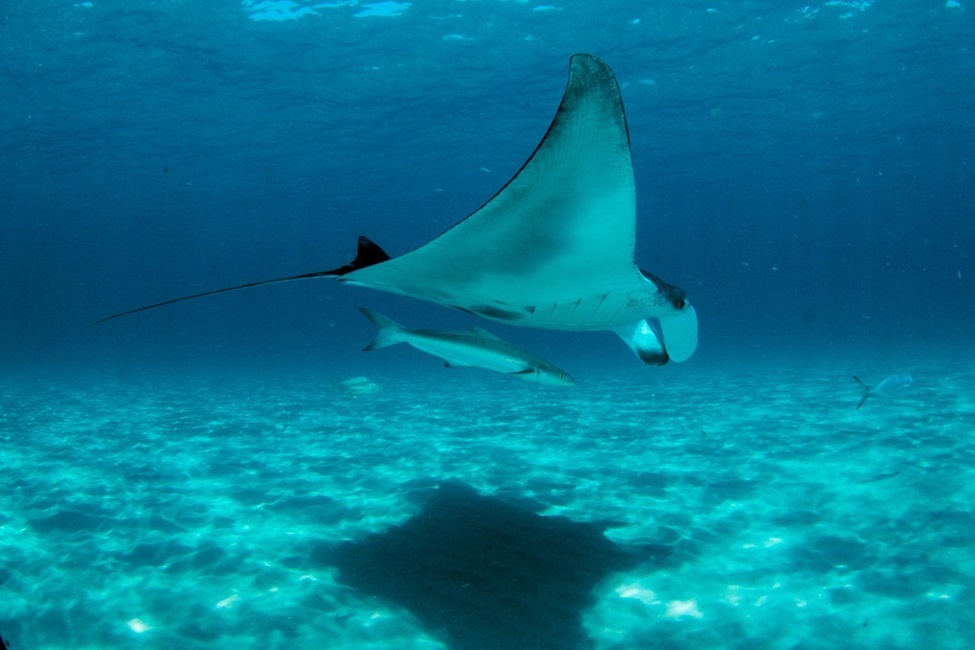Aerial Surveys Reveal Ample Populations of Rays in Southeast Florida

The giant manta ray is designated as threatened under the U.S. Endangered Species Act and is protected in Florida waters. (Photo credit: Steve Kajiura, Florida Atlantic University)
The whitespotted eagle ray (Aetobatus narinari) and the giant manta ray (Mobula birostris) are rapidly declining globally. Both species are classified by the International Union for Conservation of Nature as endangered worldwide and the giant manta ray is designated as threatened under the United States Endangered Species Act.
In Florida waters, giant manta rays and whitespotted eagle rays are protected species. To provide effective management for these species, it is necessary to gather information on their distribution and abundance.
Using aerial surveys, Florida Atlantic University researchers conducted a unique long-term (2014 to 2021) study to quantify the spatial (latitude) and temporal (month, year) abundance of the whitespotted eagle rays and giant manta rays in Southeast Florida. The researchers conducted 120 survey flights between January 2014 and December 2021 along the Atlantic Coast from Miami north to the Jupiter Inlet. They reviewed the video footage from the flights to quantify the number of rays of each species.
Results, published in the journal Environmental Biology of Fishes , showed that one or both species were seen on nearly every flight (97.5 percent). The giant manta rays were more abundant in the south and the whitespotted eagle rays were found all along the coast. Neither species seems to be deterred by the greater human population density in Fort Lauderdale/Miami.
Over the course of the study period, whitespotted eagle rays did not exhibit any seasonal difference in abundance, whereas giant manta rays were more abundant during the months of December and February. Neither species exhibited a clear trend in abundance over the study period.
“Although some years had a greater number of animals observed, there was no difference in abundance across the study period for either species, which suggests that the populations of both species appear stable in Southeast Florida,” said Stephen Kajiura, Ph.D., senior author and a professor of biological sciences, FAU Charles E. Schmidt College of Science.
The researchers also tested whether the abundances of the two species were correlated with sea surface temperature, daily chlorophyll-a concentration, used as an indicator of phytoplankton abundance, and photoperiod, or day length. They found that none of these factors correlated with the abundance of either species.
“The presence of these large bodies, slow moving giant manta rays close in the nearshore environment, makes them susceptible to injuries caused by human interactions including boat propeller injuries and entanglement with fishing gear,” said Kajiura. “A knowledge of their seasonal distribution and abundance will help to identify and protect key habitat areas. Data from our study may contribute valuable information that can be used to effectively manage both of these charismatic species in Florida and elsewhere.”
Study co-authors are Jordan M. Waldron, a Ph.D. student in FAU’s Department of Biological Sciences within the Charles E. Schmidt College of Science, and Michael McCoy, Ph.D., an associate professor of quantitative ecology, FAU Harbor Branch Oceanographic Institute.
The research was supported by funding from the Colgan Foundation.
//
Using aerial surveys, researchers quantified the spatial (latitude) and temporal (month, year) abundance of whitespotted eagle rays and giant manta rays in Southeast Florida. (Credit: Steve Kajiura, Florida Atlantic University)
-FAU-
Latest News Desk
- Researchers Identify Most Efficient Reinforced Concrete Beam DesignAn FAU engineering professor and international collaborators from Metallurgical Institute in Ukraine and Ariel University in Israel, have identified the most efficient design for reinforced concrete beams.
- FAU Launches Emergency Medical Services FellowshipFAU's Charles E. Schmidt College of Medicine launched it's sixth fellowship to strengthen emergency care through Boca Raton Regional Hospital - part of Baptist Health - and fire-rescue partnerships.
- FAU Receives NIH Grant to Investigate Amphetamine AddictionWith this grant, the FAU research team will use tiny roundworms to study how amphetamines disrupt dopamine, aiming to uncover addiction mechanisms and train the next generation of neuroscience researchers.
- New Study Links NP Autonomy to Provider Shortage ReliefA new study from researchers at FAU highlights how temporary expansions in nurse practitioner (NP) autonomy during the COVID-19 pandemic helped alleviate shortages.
- FAU's Cheryl A. Krause-Parello, Ph.D., Awarded Fulbright U.S. ScholarCheryl A. Krause-Parello, Ph.D., received a Fulbright U.S. Scholar award to study Germany's research and education systems in the academic year 2025-26, focusing on funding and university support for research.
- BEPI Poll: Hispanic Economic Optimism FallsHispanic consumers are spending less as optimism about their economic outlook dwindles amid inflation and economic uncertainty, according to a poll from the Business & Economics Polling Initiative at FAU.






